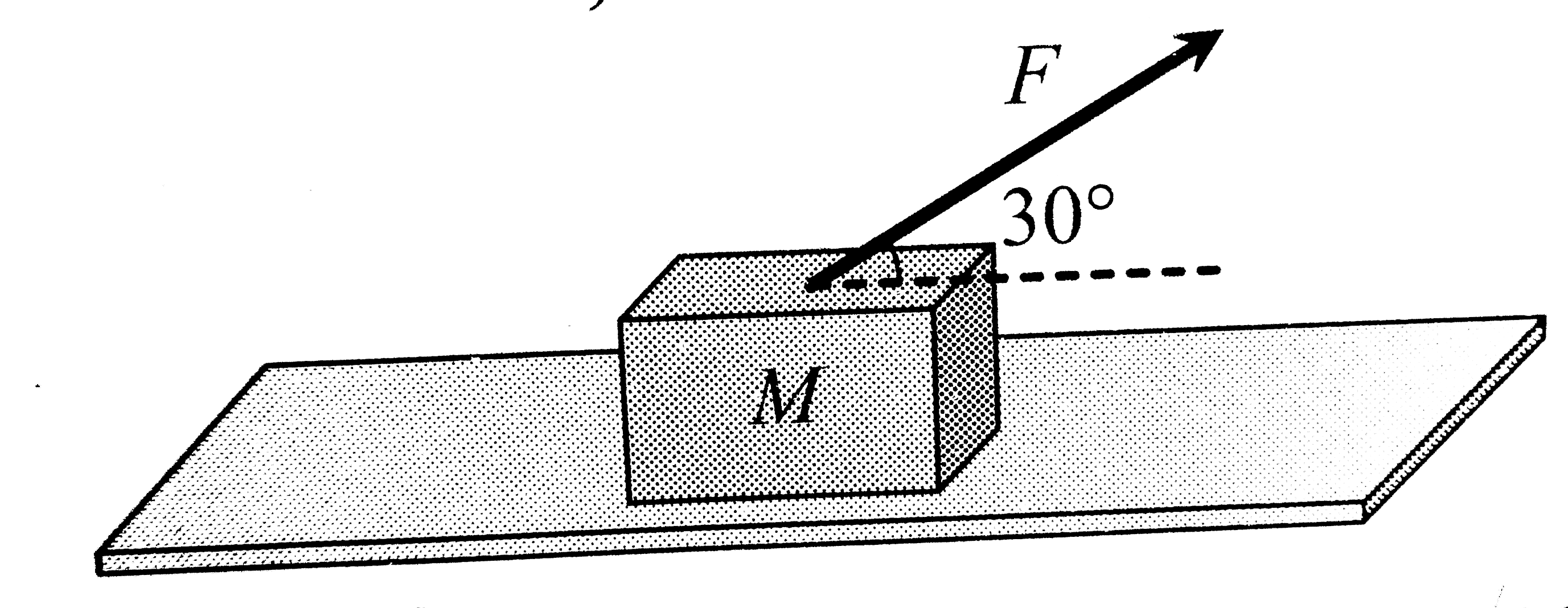A block of mass 10kg is placed on a rough horizontal surface having coefficient of friction μ=0.5 . If a horizontal force of 100N is acting on it, then acceleration of the block will be.
10m/s2
5m/s2
15m/s2
0.5m/s2
To find the acceleration of the block, we can follow these steps:
Step 1: Identify the forces acting on the block
The forces acting on the block are:
- The applied force F=100N (acting horizontally)
- The frictional force Ff (acting in the opposite direction to the applied force)
- The weight of the block W=mg (acting downwards)
- The normal force N (acting upwards)
Step 2: Calculate the normal force
Since the block is on a horizontal surface, the normal force N is equal to the weight of the block:
N=mg
Given:
- Mass m=10kg
- Acceleration due to gravity g=10m/s2
Calculating N:
N=10kg×10m/s2=100N
Step 3: Calculate the frictional force
The frictional force Ff can be calculated using the coefficient of friction μ:
Ff=μN
Given:
- Coefficient of friction μ=0.5
Calculating Ff:
Ff=0.5×100N=50N
Step 4: Apply Newton's second law
According to Newton's second law, the net force acting on the block is equal to the mass of the block multiplied by its acceleration:
ΣF=ma
The net force ΣF is the applied force minus the frictional force:
ΣF=F−Ff=100N−50N=50N
Step 5: Solve for acceleration
Now, we can set up the equation using the net force:
50N=10kg×a
Solving for a:
a=50N10kg=5m/s2
Conclusion
The acceleration of the block is 5m/s2.
---
The forces acting on the block are:
- The applied force F=100N (acting horizontally)
- The frictional force Ff (acting in the opposite direction to the applied force)
- The weight of the block W=mg (acting downwards)
- The normal force N (acting upwards)
Since the block is on a horizontal surface, the normal force N is equal to the weight of the block:
N=mg
Given:
- Mass m=10kg
- Acceleration due to gravity g=10m/s2
N=10kg×10m/s2=100N
The frictional force Ff can be calculated using the coefficient of friction μ:
Ff=μN
Given:
- Coefficient of friction μ=0.5
Ff=0.5×100N=50N
According to Newton's second law, the net force acting on the block is equal to the mass of the block multiplied by its acceleration:
ΣF=ma
The net force ΣF is the applied force minus the frictional force:
ΣF=F−Ff=100N−50N=50N
Now, we can set up the equation using the net force:
50N=10kg×a
Solving for a:
a=50N10kg=5m/s2
The acceleration of the block is 5m/s2.
Topper's Solved these Questions
- LAWS OF MOTIONBook:AAKASH INSTITUTE ENGLISHChapter:LAWS OF MOTIONExercise:Assignment (SECTION-D) (Assertion-Reason Type Questions)
Explore 15 Videos
- LAWS OF MOTIONBook:AAKASH INSTITUTE ENGLISHChapter:LAWS OF MOTIONExercise:Assignment (SECTION-B)
Explore 44 Videos
- KINETIC THEORYBook:AAKASH INSTITUTE ENGLISHChapter:KINETIC THEORYExercise:EXERCISE (ASSIGNMENT) SECTION - D Assertion - Reason Type Questions
Explore 10 Videos
- MAGNETISM AND MATTER Book:AAKASH INSTITUTE ENGLISHChapter:MAGNETISM AND MATTER Exercise:ASSIGNMENT (SECTION D)
Explore 26 Videos
Similar Questions
A block of mass 10kg is placed on a rough horizontal surface having coefficient of friction μ=0.5 . If a horizontal force of 100N is acting on it, then acceleration of the will be.
View SolutionA block of mass 10kg is placed on a rough horizontal surface having coefficient of friction μ=0.5 . If a horizontal force of 100N is acting on it, then acceleration of the will be.
View SolutionA block of mass m=5kg is resting on a rough horizontal surface for which the coefficient of friction is 0.2 . When a force F=40N is applied, the acceleration of the block will be (g=10m/s2) .

View SolutionA block of mass 10 kg is placed on a rough horizontal surface of coefficient of friction 0.1. A pulling force of 100 N acts on it at 37∘ with the horizontal. The frictional force acting on the body is ..... N.
View SolutionA force F is acting at an angle θ with horizontal on a block of mass 12 kg placed on a rough horizontal surface having coefficient of friction μ=34 as shown in the figure. The minimum value of force F to just move the block will be (g=10ms−2)
View SolutionA force F is acting at an angle θ with horizontal on a block of mass 12 kg placed on a rough 3 horizontal surface having coefficient of friction μ=34 as shown in the figure. The minimum value of force F to just move the block will be (g=10ms−2)
View SolutionA 3 kg block is placed over a 10 kg block and both are palced on a smooth horizontal surface. The coefficient of friction between the block is 0.2 . If a horizontal force of 20 N is applied to 3 kg block, accelerations of the two block in ms−2 are (take, g=ms−2)

View SolutionA block of mass 20kg is placed on a rough horizontal plane and a horizontal force of 12N is applied. If coefficient of friction is 0.1 the frictional force acting on it is,
View SolutionA block of mass 4 kg is kept on a rough horizontal surface. The coefficient of static friction is 0.8. If a forace of 19 N is applied on the block parallel to the floor, then the force of friction between the block and floor is
View SolutionA block of mass 5kg is placed on a rough horizontal plane whose coefficient of friction is 0.3. Find the least horizontal force needed to move the block along the plane and the resultant of normal reaction and the force applied.
View Solution